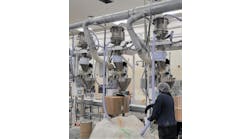The use of bulk bags to transport materials represents one of the biggest changes in the solids processing field. Particulate solids manufacturers traditionally shipped products to distributers via truck or rail with the solids in drums or pallets of bags. Truck and rail deliveries work well for large quantities but aren’t suitable for many chemicals that may be hazardous because of the risk that potential releases pose. Also, such modes of transport required large storage facilities that increased inventory costs for expensive chemicals. Bags and drums kept this cost down but added the expense of used bag/drum disposal and containment systems for feeding the chemical to the process.
[callToAction ]
Then, bulk bags appeared. I recall an early Powder Show where, perhaps, two companies offered bulk bags. These first bags were very difficult to use and often created an environmental nightmare for some chemicals. With the advent of better designs and more-convenient unloading systems, bulk bags took over a major part of the pallet bags industry. They became a more economical way to store intermediates and inventory, especially if the upstream process is slow compared to the downstream process. However, many challenges — especially for pharmaceutical and hazardous chemicals — arose along the way to making bulk bags mainstream.
Bulk bags now have gained broad acceptance — but, before converting to them, you should ask yourself four key questions:
1. How will you unload the material? You must evaluate whether your current material-handling system is compatible. Consider what befell one of my customers that decided to go with bulk bags. At its site, the first step in unloading was to have the material flow over a screener. However, the bag discharge lacked a control valve, so the operator was pinching the flow. The overloaded screen failed to remove all the fine particles, creating downstream problems. Switching to a valved bag solved the problem. Fortunately, many specialized bag designs will conform to your current system.
2. What will you do with the used bags? If possible, return these to the supplier presuming you can resolve any potential contamination issues. Otherwise you’ll need to build in the cost of sending the bags to the appropriate facility (landfill, incineration) or negotiate a material-cost adjustment from the supplier to cover the disposal cost. Selection of the type of bag, construction style and material may allow recovery of the solids by dissolving or washing the bag as part of the manufacturer’s chemical process. Many bags can find use for trash and other waste materials.
3. How sensitive is the material to attrition, agglomeration, vibration and mechanical deformation? I’ve seen cases where solids that didn’t cake or deform when placed in 50-lb bags stacked 4-ft high became a rigid block after transport in a 4-ft-high bulk bag. You must take care when loading the bag to avoid excessive stress on the solids by minimizing the drop distance. Also, don’t package warm solids from a drying operation into bulk bags because solvent may saturate the gas in the bulk solid voids. This solvent may condense in the bag, leading to recrystallization, agglomeration or even a phase change of the material.
Bulk bags now transport sludges and slurries. Many intermediate chemicals such as pastes get put into bulk bags. However, not paying attention to potential clumping can prove an expensive mistake. In one case, a plant shipped an intermediate product in bulk bags to another site and clumping took an unexpected toll there. Management finally recognized the severity of the clumping issue when the receiving department requested its third forklift in a year; the previous ones had broken backing into the bulk bags so they could be unloaded. Talk about serious clumping problems! For a more extensive article on clumping issues see “Clamp Down on Clumping.”
4. How does the sensitivity of the solids affect bag loading? Control of the environment is important to avoid getting moisture in the bags for the reasons stated above. Reused bags may need a containment system to minimize workplace contamination. Getting the correct amount of solids in the bag requires a more-sophisticated weighting system than that used for normal bags. Load cells work well but the feeder may need two feeding systems to get the right amount of solids in each bag.
At any rate, bulk bags are an important tool for solids processing and are here to stay.




